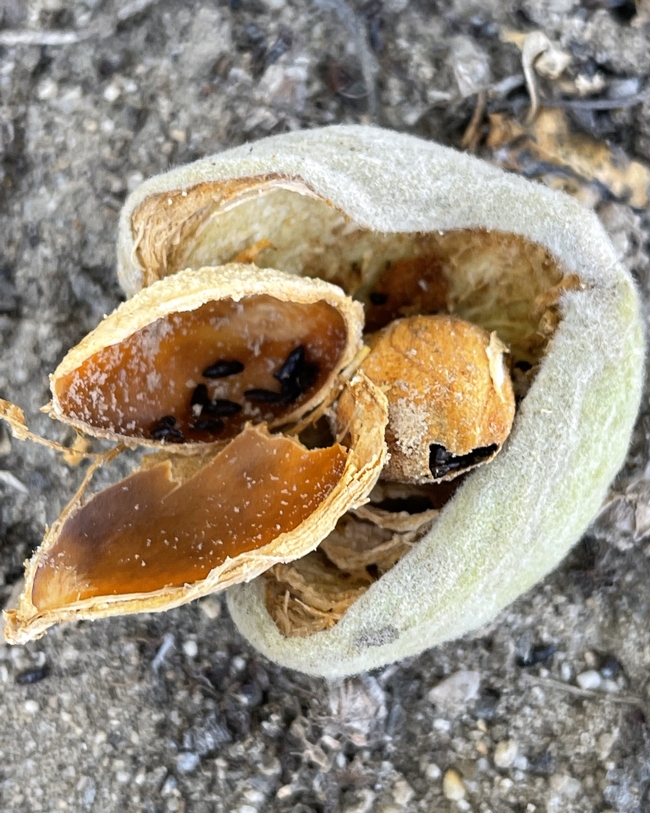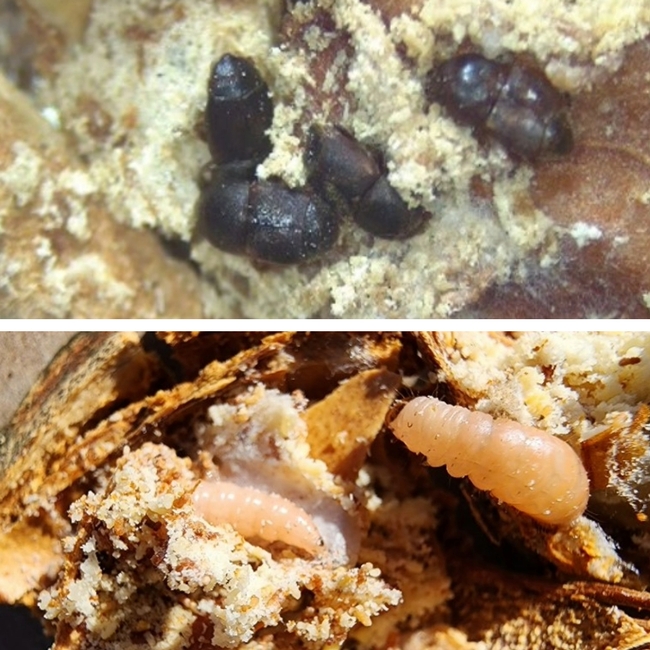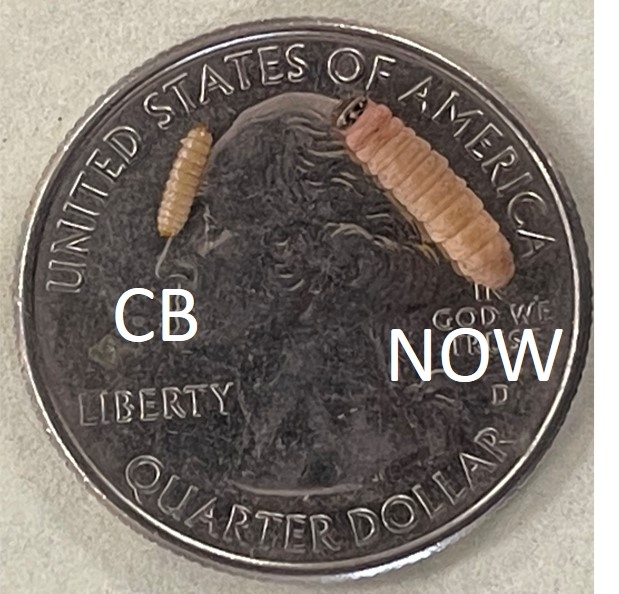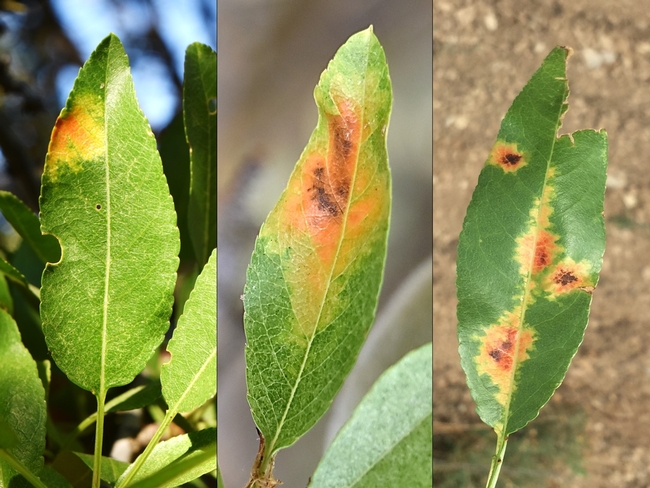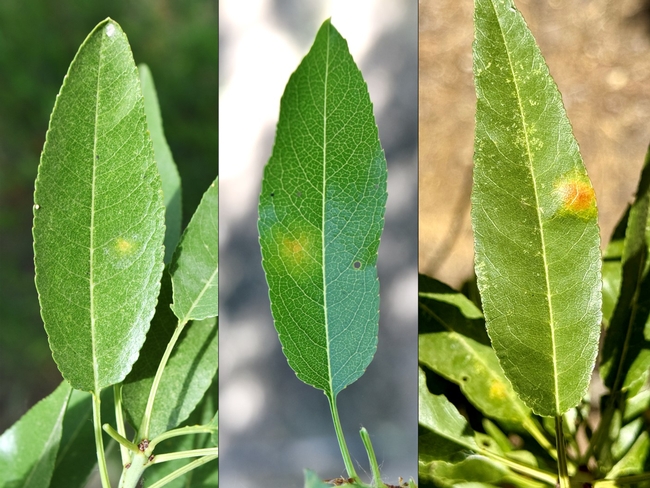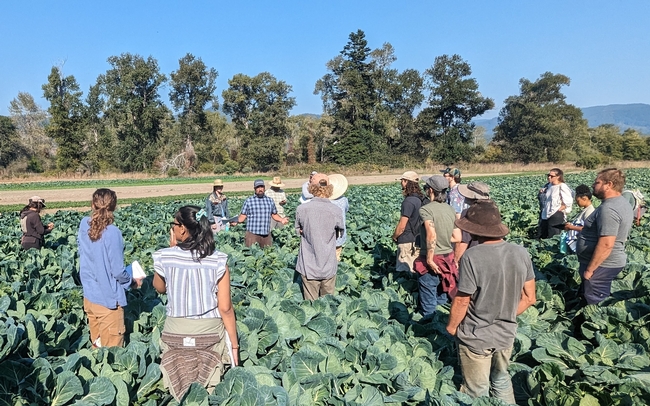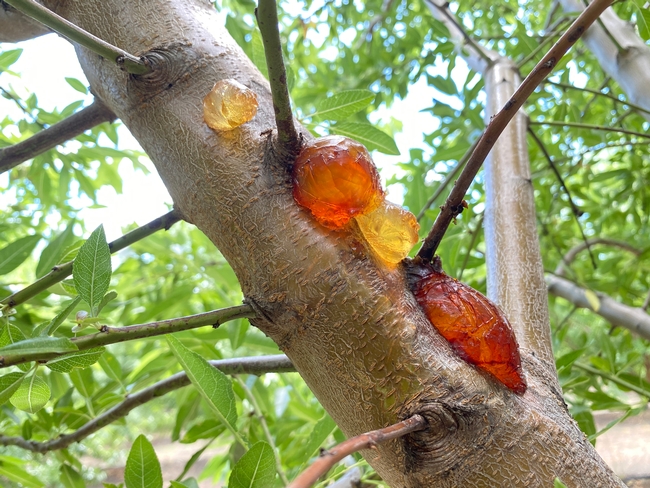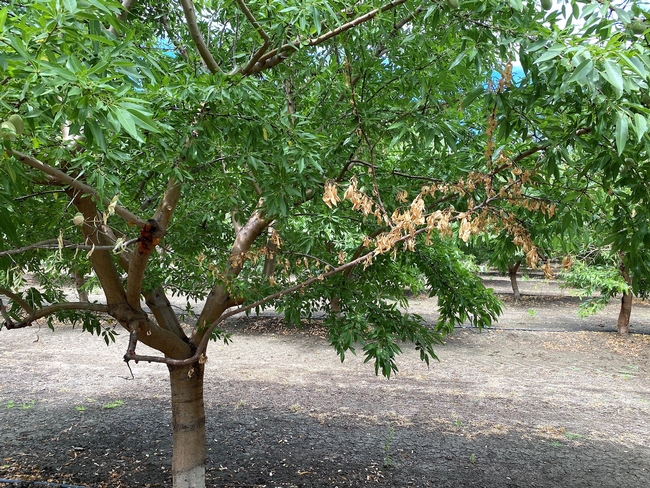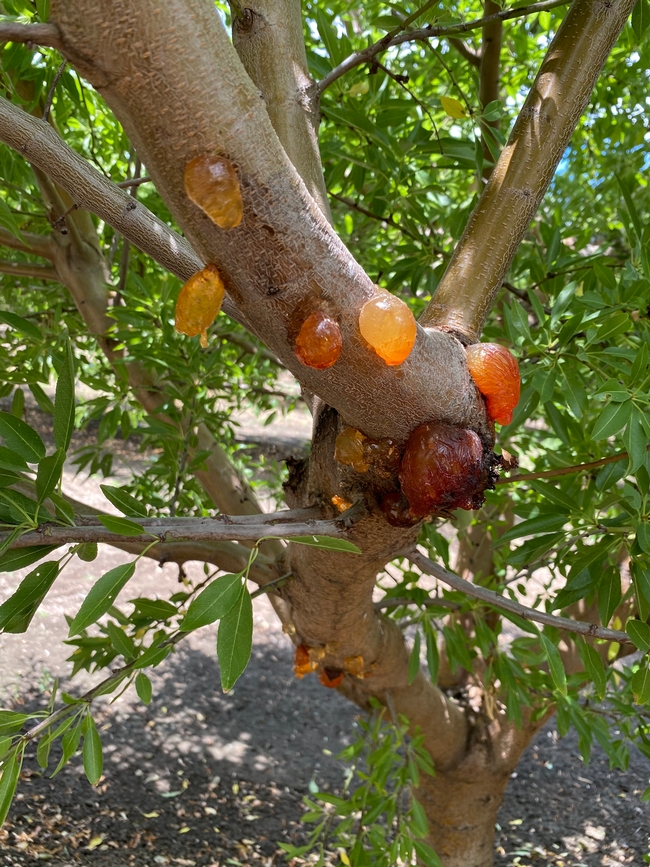Posts Tagged: pest
Visual ID guide from UC aids in managing new almond pest
Nut orchard hygiene key to control carpophilus beetle, say UCCE, UC Integrated Pest Management experts
Since the first reports of a new almond pest – the carpophilus beetle (Carpophilus truncatus) – came in during fall 2023, it has become clear that the beetle is widely dispersed across the San Joaquin Valley.
“My lab has identified infestations from every county in the San Joaquin Valley; we have found infestations in both almonds and pistachios, and we will likely find infestations in walnuts this fall,” said Houston Wilson, a University of California Cooperative Extension entomology specialist at UC Riverside. The California Department of Food and Agriculture has confirmed the beetle's presence in Stanislaus, Merced, Madera and Kings counties.
Historically a major threat to almond production in Australia, the beetle – as larvae and adults – feeds directly on the nut kernel. In California, some almond growers have lost 10 to 15% of their yield – a “significant economic loss,” according to Jhalendra Rijal, University of California integrated pest management (IPM) advisor for the region. Given the prominence of almonds as a commodity, even a 1% overall reduction statewide represents an approximately $70 million loss.
“This year there has been a lot more reports from PCAs [pest control advisers]; they're sending me the pictures of the damage and beetles,” said Rijal, noting that the increase is likely due to greater awareness of the pest.
To help almond growers identify the carpophilus beetle and develop management plans, Rijal, Wilson and their IPM colleagues have put together a visual ID guide for the beetle and the damage it causes, as well as telltale signs of navel orangeworm (Amyelois transitella) and ant damage. In particular, the experts would like PCAs and growers to differentiate between the carpophilus beetle and navel orangeworm, another key pest in almonds.
“Even though their way of causing damage looks more or less similar, we're dealing with two different types of insects,” Rijal explained. “One is a Lepidoptera moth [navel orangeworm], and the other one is a beetle – many of the management practices and biological controls would be different for these two different things.”
To control carpophilus beetle, ‘sanitize, sanitize, sanitize'
One crucial cultural practice for managing both pests, however, is destroying the remnant “mummy” nuts – the nuts that remain in the orchard postharvest. They serve as overwintering habitat for the carpophilus beetle, as well as its sustenance for the next generation of beetles in spring.
“The best way to manage this pest is to do the orchard hygiene – continuing the winter sanitation, destroying the nuts that are on the ground and on the tree and on the berms,” Rijal said.
Based on observations in Australia and locally, carpophilus beetles tend to rely more on mummies on the ground, whereas navel orangeworm generally favors mummies in the tree canopy. Correctly identifying the pest – with help from the new ID guide – enables growers to better target and prioritize their management efforts, Rijal said.
“What we are strongly emphasizing is that growers need to sanitize, sanitize, sanitize to control both pests,” Wilson added.
Correct identification of the pest would also prevent unnecessary application of insecticides, as those used for controlling Lepidoptera such as navel orangeworm would be largely ineffective on the beetle.
Indeed, another insight shared by Australian experts is that the carpophilus beetle cannot be controlled just by insecticide.
“Insecticides are not very efficient, given the cryptic nature of these beetles; exposing these beetles to the insecticide is very hard,” said Rijal, noting that the beetle spends most of its life cycle protected inside the nut.
Reporting carpophilus beetle infestation helps researchers
This harvest season, Rijal advises almond growers to harvest as efficiently as possible, to minimize the number of mummies that need to be cleaned up. And because signs of damage (like damaged hulls and frass) are most obvious during harvest time, Rijal said growers should review the new guide, using the photos and other resources to help identify potential pests.
If the grower or PCA suspects a carpophilus beetle infestation, they should contact the UCCE farm advisor in their area.
Scientists are looking to expand their knowledge about this relatively new pest to California. In the coming weeks, for example, researchers are planning to survey for the carpophilus beetle in the Sacramento Valley.
“Technically it has not been found there, but we suspect that we'll find it this fall when we go looking for it,” Wilson said.
Researchers are also collecting samples from infested orchards to better understand the biology of the species, as well as how it progresses through and responds to seasonal and climactic changes. In addition, they are analyzing data from a trial study of an insecticide that might be used as a supplemental control measure.
“This is our first full season dealing with this insect, and there are still many things we need to understand,” Rijal said. “We are continuing our research efforts on all fronts.”
Almond crop yields threatened by disease new to California
Detection of fungus causing red leaf blotch spurs call for grower vigilance
Symptoms of red leaf blotch (RLB), a plant disease caused by the fungus Polystigma amygdalinum, have been observed for the first time in California across the Northern San Joaquin Valley.
Molecular DNA testing by the laboratory of Florent Trouillas, University of California Cooperative Extension fruit and nut crop pathology specialist, has detected P. amygdalinum. Pest identification was confirmed by the California Department of Food and Agriculture and U.S. Department of Agriculture.
The disease, named for the characteristic orange-to-dark red blotches that appear on infected leaves, is typically nonlethal for trees but has been a long-standing problem for almond-growing regions across the Mediterranean. Causing trees to lose their leaves prematurely, the fungal pathogen can significantly diminish crop yields in the current year and the next.
“It is one of the most severe diseases of almonds for Spain and the Middle East,” said Trouillas, an associate professor in the UC Davis Department of Plant Pathology. He recently co-authored an explanatory article on the UCCE San Joaquin Valley Trees and Vines blog.
With symptomatic trees seen in multiple orchards across Madera, Merced, San Joaquin and Stanislaus counties, Trouillas said RLB is already “somewhat widespread.”
“From the first observations so far, it seems like it affects some of the most-planted cultivars, like Nonpareil and Monterey,” he added. “We've observed it in a diversity of cultivars already.”
UC Cooperative Extension specialist urges taking preventive measures
According to Trouillas, RLB caused by P. amygdalinum is “highly specific” to almond trees, and generally only affects their leaves. Infection typically happens at petal fall, when small leaflets are first emerging and most susceptible to disease. After the pathogen's latent period of about 35 to 40 days, the first symptoms appear – small, pale-yellow spots on both sides of the leaves.
Those blotches become yellow-orange and then reddish-brown in the advanced stages of the disease during June and July. Now, with RLB symptoms becoming more prominent, Trouillas and UC Cooperative Extension advisors across the Central Valley have seen an uptick in calls.
“PCAs [pest control advisers] have been confused because they've never seen anything like this,” said Trouillas, noting that the yellow-orange-red blotches are symptoms unique to RLB and cannot be confused with other known almond diseases.
Applying fungicides after RLB symptoms appear is ineffective, Trouillas said. The best thing growers can do at this point is to report symptomatic trees to researchers so they can track the prevalence and distribution of the disease.
Growers who see signs of this new disease in their orchard should contact their local UC Cooperative Extension farm advisor.
Preventive measures are the best way to manage RLB, Trouillas said. He urges concerned growers to think ahead to next winter/spring and plan for fungicide applications at petal fall and – if rains persist – also at two weeks and five weeks after petal fall. Fortunately, those are the same three key timings for managing other diseases, like shot hole and almond anthracnose.
“Because RLB is something that is introduced and potentially aggressive, it will be important for growers to keep that in mind next year and be on schedule for next year's spraying program,” Trouillas said.
Additional information on RLB can be found at https://www.sjvtandv.com/blog/first-detection-of-red-leaf-blotch-a-new-disease-of-almond-in-california.
Diagnosing herbicide problems takes detective work
Field day offers examples, tips for solving the mystery
A grower applies an herbicide to his tomato plants, or thinks a neighbor's treatment is drifting over her almond trees. A short time later, the leaves start to bleach or shrivel. Was it the herbicide? Or maybe water stress? Soil nutrients? Perhaps an insect?
Figuring out the causes of crop problems takes detective work, and like solving any mystery, it starts with knowing the signs, gathering evidence and asking questions.
The Diagnosing Herbicide Symptoms field day at UC Davis was an opportunity to see, up close, the shriveled cotton, scorched corn and dying sunflowers that can result when herbicides are applied incorrectly. Using the right herbicide – in the right proportion, at the right time and in the right field – can make the difference between a thriving crop and a financial loss.
A top take-away to avoid problems: “Don't do stuff at night!” laughed Becky Wheeler-Dykes, a UC Cooperative Extension farm advisor attending the June 26 event to better serve growers in Glenn, Tehama and Colusa counties. “The packages look the same. People grab the wrong jug.” And then, disaster.
Instructors were Brad Hanson, professor of Cooperative Extension; and Kassim Al-Khatib, the Melvin D. Androus endowed professor for weed science; both in the Department of Plant Sciences. They were joined by John Roncoroni, a Cooperative Extension emeritus farm advisor rooted in the department's weed science program. Attendees were a mixture of people from agriculture, industry, government officials, university researchers and Cooperative Extension advisors. The event was hosted by the Weed Research and Information Center, based in the Department of Plant Sciences.
Out in a field west of campus, visitors could see the progression of damage, from control plots with green and healthy crops to plants that looked sadder as herbicide concentrations increased. Visitors could see the patterns of damage for common foliar chemicals such as glyphosate, paraquat, and 2,4-D, as well as soil-applied herbicides from several chemical classes.
“There's a lot of detective work,” said Stephen Chang, a master's student in Hanson's lab aiming for a career in Cooperative Extension. “For example, the company that makes the herbicide says there shouldn't be a problem, but the grower says, there is a problem. This course helps with developing the skills to figure out what happened.”
It might not be the herbicide at all
Detective work and problem-solving frame the approach, Hanson explained. The cause of crop damage can be simple or complex. Like a good mystery, what appears to be a clue can turn out to be a red herring. Professionals need to draw on their inner Sherlock Holmes to observe and document symptoms, look for patterns in the plants and in the field, ask questions, gather information about the larger environment and collect samples.
An herbicidal Agatha Christie would then suggest: What if it's not herbicide damage at all? Participants learned to consider the possibility of insects, pathogens and viruses, as well as problems with water, nutrients, soil condition and even root damage from cultivation practices.
Hanson recalled puzzling over symptoms he found in an orchard. The culprit? “A leaking natural gas line,” he said.
More resources for herbicide issues
Participants also heard from Molly Mathews, deputy agriculture commissioner from Yolo County, on how a field investigation is conducted. Lawyer Robert Davies, of Donahue Davies LLP in Folsom, outlined the basics of what happens when there are lawsuits related to crop damage from herbicide drift.
The Diagnosing Herbicide Symptoms field day is part of a larger program of education and outreach offered through the Weed RIC, said director Julia Stover-Blackburn. It was the first time the event has been offered since the COVID-19 pandemic, she added.
- For more information about field days and resources, visit the Weed RIC webpage.
- For a thorough discussion of herbicide symptoms, visit this page overseen by Al-Khatib and sponsored by University of California Agriculture and Natural Resources.
- This online course follows an earlier version of the Diagnosing Herbicide Symptoms field program.
This story was originally published on the UC Davis Department of Plant Sciences website.
Report outlines top concerns in California organic agriculture
Organic Agriculture Institute needs assessment refines how it can address pressing challenges
The explosive growth of organic agriculture in the U.S. – reflected in a 90% increase in organic farms from 2011 to 2021, according to U.S. Department of Agriculture statistics – has come at a cost for some farmers. With new farming operations increasing the supply of organic commodities, along with consolidation of buyers, growers report that their profit margins are not what they used to be.
Those market size considerations are among the challenges highlighted in a new report detailing the initial findings by the University of California Organic Agriculture Institute on the most pressing needs of the state's organic sector. OAI gathered and analyzed data from 423 responses to an online grower survey, over 60 interviews with stakeholders across the organic community, and additional observations from farm visits and workshops.
The report describes other frequently mentioned systemic priorities, such as maintaining integrity of the term “organic,” developing a market for organic seeds, spreading consumer awareness, and alleviating the burdens of organic certification and reporting.
Shriya Rangarajan, the postdoctoral researcher with OAI leading this statewide needs assessment, said that the reported challenges varied by organic status (fully certified, transitioning to organic, or a mixed farm with some conventional), type of crop, as well as size of the operation. She noted survey respondents were roughly representative of the sector overall – 70% small-scale growers and 30% medium and large.
“Organic is not a homogenous industry, to say the least – small growers and large growers are very different; for small growers, their challenges tend to be financial and regulatory, especially relating to certification requirements and labor,” said Rangarajan. She added that larger growers mentioned different types of challenges, weeds and pest pressures for instance, given the difficulty in controlling managing these at scale without the use or availability of organic inputs.
Organic Agriculture Institute key to sharing resources across state
Another common theme from the assessment is that the organic sector needs more accessible resources to address those myriad concerns. For OAI, established in 2020 under UC Agriculture and Natural Resources, the initial findings validated and refined the direction of its research and extension programs.
“As a new organization, we've been trying to figure out where we fit into this ecosystem and how we can support it,” said Houston Wilson, a UC Cooperative Extension entomology specialist who has served as OAI's director since its founding.
Because OAI was envisioned as a hub of resources and connections for California's organic community, Wilson and his colleagues are especially interested in understanding how its constituent members obtain information – and how OAI can improve their access.
“Growers are finding it difficult to navigate the resources that exist for organic agriculture, like technical information, financial support, compliance and certification support,” Wilson said. "While we'd like to see more resources for organic in general, those that currently exist can sometimes be hard to navigate or it can be hard to know where to go for the right thing – that became really apparent early on.”
While some producers are contacting OAI directly with their questions, Wilson is eager to develop tools and systems that can serve the community more broadly. For example, Wilson and Krista Marshall – OAI's policy and partnerships coordinator – are currently beta-testing a new map tool, built in conjunction with UC ANR's Informatics and GIS (IGIS) team. The map, expected to be ready in fall 2024, will enable users to click on their county and see all available resources related to organic agriculture.
Wilson added that OAI will have four full-time staffers by fall, further expanding its research, extension, and education efforts. After holding four field events this past year, OAI aims to increase activities in the coming year, including not just field events but also online resources, webinars and more. Also, a new training and technical assistance coordinator will be tasked with bringing Cooperative Extension advisors and other technical assistance personnel across the state up to speed on a range of organic topics, so they can more effectively answer questions from clientele in their region.
New survey aims to trace crucial organic knowledge networks
Although the OAI team has gained a sense of how information is shared across the organic community (and started to formalize those interconnections through a California Organic Agriculture Knowledge Network), they are now developing a survey to study those relationships more systematically.
“We're trying to understand what kind of knowledge resources people tap into, which is something that has come up repeatedly in our needs assessment,” Rangarajan said. “We're trying to understand who people are speaking to because, at the end of the day, organic is still a relatively small part of agriculture in California, and that makes it more fragmented. So trying to connect those different parts becomes important.”
Once Wilson has a more nuanced understanding of organic knowledge networks, he will be able to strategize and position OAI – and the UC – as a more effective partner and contributor in the sector.
“Given the history of organic, growers have had to rely on each other a lot,” Wilson explained. “We understand that the university has unique expertise to bring to the table, but we also acknowledge that there's all these other knowledge holders out there, so one of the roles that we see ourselves having is helping to facilitate those connections, strengthen them and increase the frequency of interaction.”
That may include further supporting efforts that connect transitioning organic farmers with experienced growers (a mentorship program led by Certified California Organic Farmers, or CCOF), or giving more structure to grower-researcher partnerships that can help address a host of production challenges. In OAI's grower survey, weed management topped the list, followed by water and disease issues, all exacerbated by climate variability.
“I think a lot of the real innovation changes are coming through growers experimenting with their own practice,” Rangarajan explained. “From a research perspective, one of the best ways to take this forward would be to formalize those experiments in some way so that knowledge becomes more reportable.”
And collaboration on “organic topics,” such as finding alternatives to synthetic pesticides, are a boon to the entire agricultural sector – conventional growers included.
“Everyone is trying to reduce pesticide use; everyone is trying to reduce environmental impacts,” Wilson said. “You don't have to be certified organic to benefit from organic research; these practices can be used by anyone.”
The report with OAI's initial findings on organic needs can be found at: https://ucanr.edu/sites/organic/files/396228.pdf.
Almond growers should prepare for possibility of unusual disease outbreak
Wet winter, El Niño create favorable conditions for aerial Phytophthora pathogen
With heavy rains in the forecast amid strengthening El Niño conditions, almond growers should be on the lookout for a rare disease that can cause severe damage to their orchards, according to Florent Trouillas, a University of California Cooperative Extension specialist in fruit and nut pathology.
Phytophthora, soilborne microorganisms dubbed “water molds” because of their dependence on water, typically cause root and crown rot at the base of trees. But a few aerial Phytophthora can travel upwards and infect the higher parts of the tree. One species – Phytophthora syringae – is drawing special attention due to an unprecedented outbreak last winter, fueled by the atmospheric rivers that lashed California.
“It was found statewide – meaning in every almond-producing county – and disease incidence in orchards ranged from 10% of the trees infected to 75%,” said Trouillas, a UC Davis plant pathologist whose lab is based at UC Agriculture and Natural Resources' Kearney Agricultural Research and Extension Center in Parlier.
Trouillas and his colleagues, UC Davis graduate student Alejandro Hernandez and UC Riverside plant pathology professor Jim Adaskaveg, recently published a detailed online article describing the pathogen, which can infect a range of crops but mainly impacts almonds in California.
Although it doesn't kill the tree, the disease causes branch dieback that requires significant additional work and expense for almond growers. In 2022, almonds were the state's fourth-highest valued commodity, at $3.52 billion.
During last year's aerial Phytophthora outbreak, researchers also observed a new and troubling phenomenon: P. syringae, historically known to attack the cuts caused by pruning, was directly infecting the young shoots on almond trees – without any wounds.
“This was really the first time we had seen widespread evidence of infection on the twigs,” Trouillas said.
Although generally rare, outbreaks of P. syringae have been traditionally associated with wet El Niño years, according to Trouillas – and recent and persistent rain across the state should have growers on high alert.
Prune in dry weather, monitor, mitigate if necessary
While almond growers tend to prune during the downtime of winter, they should keep an eye on the forecast and aim for a 10- to 14-day window of dry weather to perform those tasks, whether training young trees or maintaining the established ones.
“If growers were to prune around a rain event – before, during or shortly after – this increases the likelihood of infection because this pathogen moves around with water,” Trouillas explained.
Researchers speculate that P. syringae, normally found in the soil, gets carried into the upper parts of a tree through strong winds and heavy rain. Alternatively, harvest processes like shaking and sweeping also produce air movements that may blow the microorganism into the canopy, where it waits for a favorable wet environment. The pathogen then attacks the wounds or young shoots, producing characteristic cankers and gumming.
The patterns and colors of the gum balls are keys to diagnosing an infection of this particular aerial Phytophthora. Starting around bloom time (mid-February), growers should monitor pruning wounds and young shoots on their trees, especially in the canopy, for signs of the disease.
The unique coloration of the gum balls – ranging from gold and amber to dark burgundy to bright red (see photos) – generally indicates P. syringae infection. But growers are urged to contact their local Cooperative Extension advisor for confirmation.
“It is super critical for growers that, whenever they see gumming, not to assume that it is this aerial phytophthora, because there are many other diseases that can cause gumming on the tree,” Trouillas said.
If the diagnosis is confirmed, growers may apply a compound that can mitigate the infection. The plant pathologists' recent writeup describes several curative treatment options, as well as a preventive measure that reduces the amount of pathogen in the soil and thus the likelihood of infection.
For more information on the pathogen's history and biology, as well as various options for disease management, visit the article on Sacramento Valley Orchard Source: https://www.sacvalleyorchards.com/almonds/trunk-soil-diseases/aerial-phytophthora-outbreaks-in-wet-years.


